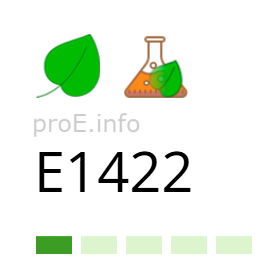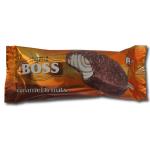
Other names for the additive (synonyms)
General Information
Food additive E1422 (acetylated distarch adipate) is a starch modified using acetic acid anhydride and adipic acid anhydride. It is a food starch in which one or more original characteristics have been changed through special treatment. Thanks to this modification, it can withstand high temperatures.
Additive E1422 is used in the food industry as an emulsifier, stabiliser, or thickener.
Modified starch is obtained through chemical processing of natural starch with the help of auxiliary reagents. Natural plant starch is used as the base for its production—potato, corn, wheat, or tapioca starch.
In the first stage of production, native starch reacts with bifunctional reagents (adipic acid or its anhydride). This results in distarch adipate. Upon further treatment with vinyl acetate or acetic anhydride, acetylated distarch adipate is formed.
Food additive E1422 and modified starches in general are not genetically modified products. The starch itself and its modifications may contain only traces or minor fragments of altered DNA if derived from genetically modified raw materials.
Modified starch dissolves well in hot water, forming a paste. It has moderate solubility in cold water. It does not dissolve in alcohol or other organic liquids. Additive E1422 is resistant to retrogradation and shearing, mechanical stress, freeze–thaw cycles, and low pH levels. It also withstands heat treatment and retains its properties during long-term storage.
Main characteristics of food additive E1422:
- Colour – white or slightly yellowish.
- Odour – slight vinegar-like smell.
- Taste – none.
- Consistency – powder consisting of granules, flakes of amorphous powder, or coarse particles (depending on the drying method—if the starch was treated with heat in the presence of acid or alkali, slight fragmentation occurs).
Effects on the Body
Benefits of additive E1422
In the digestive tract, additive E1422 is broken down in the same way as native starch, but is absorbed less efficiently, like all substances with modified structures. Starch E1422 in food products does not provide any beneficial properties to the human body. However, it also poses no harm.
Risks of additive E1422
Modified starch is generally considered a safe additive. However, excessive consumption may cause bloating and diarrhoea.
Studies used for the EFSA Food Additives Panel report showed that additive E1422 does not cause carcinogenic effects in animals even at high doses. Acetylated distarch adipate also does not exhibit mutagenic properties.
No maximum permitted intake level has been set for additive E1422, as it is considered safe.
Uses
In the food industry, additive E1422 is used as a thickener, filler, stabiliser, and emulsifier. Modified starch helps adjust the consistency of products and serves as a moisture-retaining, gelling, or glazing agent. It is actively used in the production of:
- fermented milk products – yoghurts, dairy drinks, sour cream;
- curd and processed cheeses;
- sauces, ketchups;
- instant cereals, breakfast cereals;
- swelling breadings and extruded products;
- pickled cucumbers and gherkins;
- canned fruits and fruit fillings for open pies;
- canned soups;
- low-cost meat products made from lower-grade raw materials—modified starches are needed to bind free moisture released during heating.
Acetylated distarch adipate is also included in the composition of canned baby food for children under the age of 3.
Legal Status
Food additive E1422 is permitted for use in the food industry in most countries as safe for human health. It is approved in Ukraine, the European Union, Japan, Australia, and the United States.
In the Codex Alimentarius, stabiliser E1422 is listed in 11 standards, including those for fish, mushroom, and vegetable preserves, flavoured dairy products, and GMP broths.
